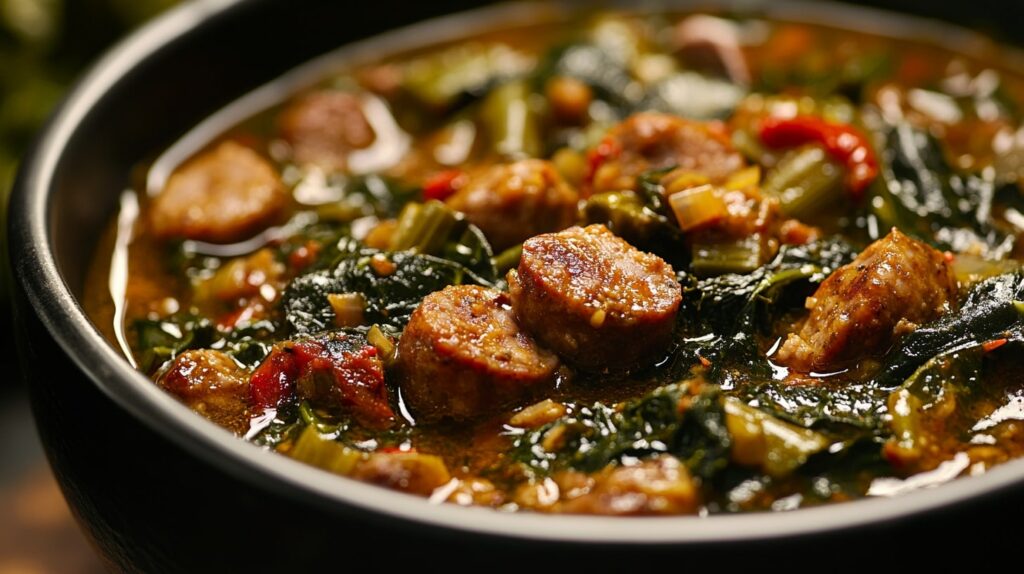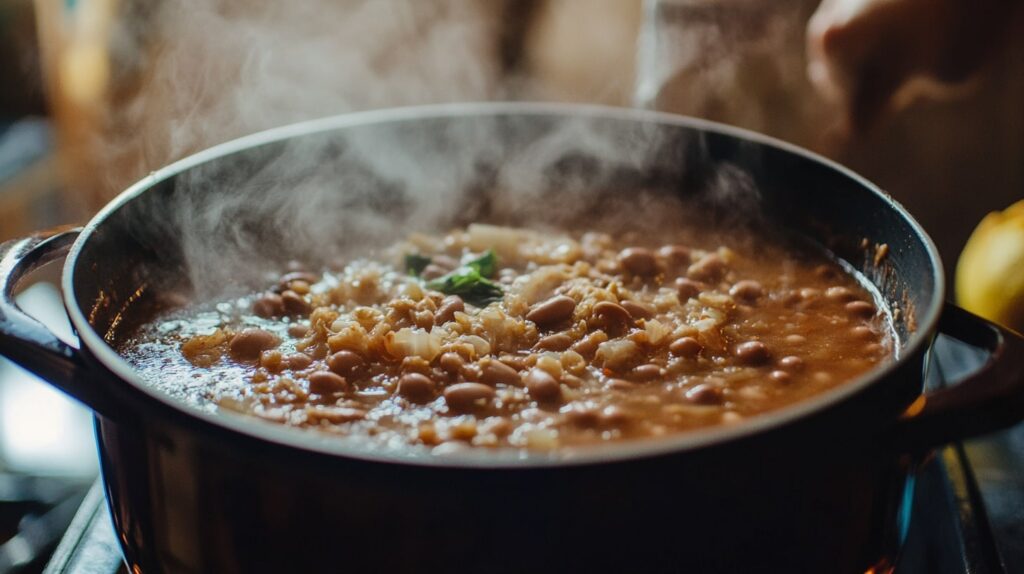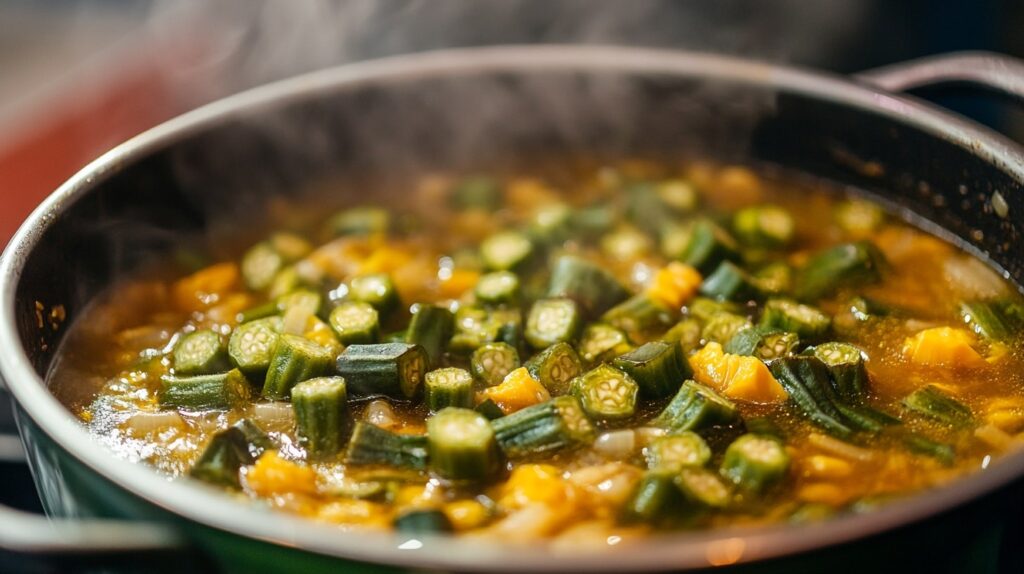
There’s something comforting about a steaming bowl of swamp soup. With its rich flavors, hearty ingredients, and vibrant appearance, it’s a dish that deserves the perfect texture. But if your swamp soup turns out thin or watery, it can feel like a disappointment. So, what’s the best way to thicken swamp soup to achieve that delightful, satisfying consistency? Whether you’re a seasoned cook or a soup newbie, you’re in the right place. Let’s dive in!
Table of contents
Why Swamp Soup Deserves the Perfect Thickness
Imagine biting into a thick, luscious spoonful of swamp soup. The texture is rich and velvety, each ingredient coated perfectly in the broth. Now, picture the same soup as thin as water—flavors diluted, the experience flat and unsatisfying. Clearly, the difference is striking. Finding the right way to thicken swamp soup ensures the perfect texture.
A well-thickened swamp soup does more than just taste good. In fact, it:
- Holds Flavor Better: Thick soups let flavors cling to each bite.
- Fills You Up: A thicker consistency makes the soup more hearty.
- Feels Luxurious: A smooth, rich texture elevates the eating experience.
In short, texture is everything. It can make or break your swamp soup. Therefore, paying attention to thickness is essential if you want to create the best possible version of this dish.
The Basics of Swamp Soup Thickness
Before we dive into each way to thicken swamp soup, let’s cover the basics. What exactly is swamp soup, and why does thickness matter so much?
What Is Swamp Soup, Anyway?
Swamp soup isn’t just a quirky name. In reality, it’s a flavorful Southern-inspired dish that combines hearty ingredients like:
- Greens (spinach, kale, collard greens)
- Meats (sausage, chicken, or seafood)
- Spices (paprika, cayenne, garlic)
- Vegetables (okra, onions, bell peppers)
The term “swamp” comes from its slightly murky, rich broth. But don’t let the name fool you. This soup is bursting with complex flavors that’ll keep you coming back for more. In addition, the combination of vegetables and spices makes it a nutritious option.
Why Thickness Matters in Soup
Why does it matter if your soup is thick or thin? Well, a thin soup can taste diluted, making the ingredients float around like they’re lost at sea. On the other hand, thick swamp soup creates harmony. The broth hugs the ingredients, blending flavors and textures together beautifully.
Key Benefits of Thick Soup:
| Benefit | Why It Matters |
|---|---|
| Flavor Cling | Keeps flavors attached to every bite. |
| Hearty Texture | Makes the soup more filling and satisfying. |
| Aesthetic Appeal | Thick soup looks more appealing and appetizing. |
In summary, the right texture enhances the overall experience, making every spoonful of swamp soup more enjoyable. So, getting the thickness just right is crucial for the best results.
Common Thickening Challenges
Alright, now that we know why thickness is crucial, let’s talk about the hurdles. Have you ever ladled out your soup only to find it’s more like flavored water? Or perhaps your thickening attempts turned it into a gloopy mess? Either way, these challenges can be frustrating.
When Your Swamp Soup Turns Into Swamp Water
If your swamp soup ends up too thin, it feels like all the hard work has gone to waste. Some common reasons for watery soup include:
- Too Much Liquid: Adding more broth than needed can easily make your soup too thin.
- Lack of Thickening Agents: Forgetting to include ingredients that naturally thicken the broth often leads to disappointment.
- Short Cooking Time: Not giving the soup enough time to reduce and thicken can also result in a watery texture.
As you can see, even small missteps can lead to less-than-perfect results. Fortunately, understanding these challenges helps you avoid them.
Why Soup Thickness Is So Hard to Get Right
Achieving the perfect thickness can feel like a balancing act. But why is it so tricky? Well, there are a few reasons:
- Ingredient Ratios: Too many veggies or too much meat can affect how much liquid you need.
- Cooking Methods: Slow cookers and stovetops cook differently, which can impact texture.
- Thickening Timing: Adding thickeners too early or too late can mess things up.
However, don’t worry! Once you understand the methods and tips, you’ll be thickening like a pro. Plus, a little patience and practice go a long way.
📝 “Cooking is like chemistry. Get the ratios right, and you’ll create a masterpiece. Get them wrong, and you might end up with soup that’s more science experiment than supper.”
Classic Thickening Techniques
Now, let’s explore each way to thicken swamp soup ! These methods are simple and effective. These techniques are simple, effective, and use ingredients you probably already have in your kitchen. So, let’s dive in and explore these options.
🧈 The Roux Route: Butter and Flour for Instant Thickness
A roux is one of the most classic ways to thicken soups. It’s a combination of equal parts butter and flour, cooked until it forms a paste. This method gives your soup a smooth, velvety texture.
How to Make a Roux:
- Melt Butter: In a skillet, melt 2 tablespoons of butter over medium heat.
- Add Flour: Stir in 2 tablespoons of flour.
- Cook and Whisk: Whisk continuously until the roux turns a pale golden color (about 2-3 minutes).
- Incorporate Into Soup: Gradually add the roux to your swamp soup while stirring.
Tip: Cook the roux longer for a deeper flavor, but don’t let it burn! Additionally, make sure to whisk constantly to avoid lumps.
🌽 The Power of Cornstarch: Easy, Fast, and Effective
If you need a quick fix, cornstarch is your best friend. Not only is it gluten-free, but it also works in minutes. Plus, it’s a staple in most kitchens.
How to Use Cornstarch:
- Make a Slurry: Mix 2 tablespoons of cornstarch with 2 tablespoons of cold water.
- Add to Soup: Pour the slurry into your hot soup while stirring.
- Simmer: Let it cook for 2-3 minutes until thickened.
Pro Tip: Don’t add cornstarch directly to hot soup, or you’ll get clumps. Always make a slurry first.
🥣 “Cornstarch is like a magic wand for thin soups. A quick swirl, and poof—instant thickness!”
🥔 The Magic of Potatoes: Creamy, Hearty, and Natural
Potatoes are a fantastic natural thickener. They add creaminess without changing the flavor too much. Plus, they’re easy to use!
Ways to Use Potatoes:
- Diced Potatoes: Add peeled, diced potatoes to your soup and let them simmer. The starches will naturally thicken the broth.
- Mashed Potatoes: For a quicker method, stir in some instant mashed potato flakes.
- Potato Puree: Blend a boiled potato with a bit of broth, then mix it into the soup.
Nutrition Facts for Classic Thickeners
| Thickener | Calories | Carbs | Fat | Protein |
|---|---|---|---|---|
| Roux (2 tbsp) | 180 | 14g | 10g | 2g |
| Cornstarch (2 tbsp) | 60 | 14g | 0g | 0g |
| Potato (1 medium) | 110 | 26g | 0g | 2g |
🥦 Plant-Based Thickeners for Swamp Soup
Now that we’ve covered the classic methods, let’s explore some plant-based options to thicken your swamp soup. These offer a plant-based way to thicken swamp soup while keeping it healthy. or need to keep your dish vegan or gluten-free. Additionally, they add extra nutrition and flavor while maintaining that hearty texture you crave.

🌱 A Healthy Way to Thicken Swamp Soup with Pureed Beans
Beans are a fantastic way to thicken your swamp soup while also boosting the protein content. They blend in smoothly, adding a creamy texture without overpowering the taste. Plus, they’re budget-friendly and pantry staples for many households.
How to Use Pureed Beans:
- Cook Your Beans: Use canned beans like cannellini, navy, or black beans. If you’re using dry beans, cook them until soft.
- Blend Smooth: Puree the beans with a little bit of your soup broth until they’re completely smooth.
- Mix It In: Add the bean puree back into the soup, stirring thoroughly. Simmer for a few minutes until everything thickens nicely.
This method not only thickens the soup but also adds fiber, making it a healthier option.
💡 Tip: If you’re aiming for a richer flavor, try blending the beans with garlic or herbs before adding them to the soup.
🥒 A Traditional Way to Thicken Swamp Soup Using Okra

Okra might have a bad rap for being slimy, but that “slime” is exactly what makes it a fantastic thickener! Traditionally used in Southern and Creole cooking, okra is a natural way to add body to your swamp soup.
How to Use Okra:
- Chop It Up: Slice fresh or frozen okra into small pieces.
- Add to the Soup: Toss the okra into your simmering swamp soup.
- Let It Work: As it cooks, the okra releases its mucilage (that’s the slimy stuff), which thickens the soup beautifully.
In addition, okra is rich in vitamins and minerals, so you’re not just thickening your soup—you’re making it healthier!
🍲 “Okra: The superhero you didn’t know your soup needed. Its slime saves the day!”
💡 Tip: If you want to reduce the sliminess, soak the okra in vinegar for 30 minutes before adding it to the soup.
🌿 Arrowroot: A Gluten-Free Thickening Wonder
If you’re looking for a gluten-free alternative to flour or cornstarch, arrowroot powder is an excellent option. It’s derived from a tropical plant and works well for thickening soups, sauces, and gravies.
How to Use Arrowroot:
- Create a Slurry: Mix 1 tablespoon of arrowroot powder with 2 tablespoons of cold water.
- Add to Soup: Stir the slurry into your hot soup while it’s simmering.
- Watch It Thicken: The soup will thicken almost instantly, and you’ll get a clear, glossy finish.
Arrowroot works well because it doesn’t alter the flavor and thickens at lower temperatures compared to cornstarch.
💡 Note: Avoid boiling the soup after adding arrowroot, as it can break down and lose its thickening power.
Unconventional Ways to Thicken Your Soup
Sometimes, you need an unconventional way to thicken swamp soup. Luckily, there are plenty of unconventional methods to thicken your swamp soup when you don’t have the usual ingredients on hand. These methods are fun, effective, and can save you in a pinch.
🍞 Bread Crumbs: Grandma’s Secret Weapon
If you’ve ever wondered how your grandma made her soups so rich and hearty, bread crumbs might have been her secret ingredient. This old-school trick is perfect when you need to thicken your soup quickly and easily.
How to Use Bread Crumbs:
- Crumb It Up: Take stale bread and turn it into fine crumbs using a blender or food processor.
- Stir It In: Add the bread crumbs directly into the soup while it’s simmering.
- Let It Thicken: Allow the crumbs to absorb the liquid and dissolve into the broth, creating a thicker consistency.
Not only does this method thicken your soup, but it also helps reduce food waste. Win-win!
🥚 Egg Yolks: Luxurious, Silky Texture
Egg yolks are another unconventional but effective way to add richness and thickness to your swamp soup. They give the soup a silky, luxurious texture that’s hard to beat.
How to Use Egg Yolks:
- Whisk Yolks: In a small bowl, whisk 2-3 egg yolks with a bit of hot soup broth to temper them.
- Add Slowly: Slowly pour the yolk mixture back into the soup, stirring constantly.
- Don’t Boil: Heat gently, but avoid boiling to prevent the yolks from curdling.
This method works well for creamy soups and adds a touch of sophistication to your dish.
🥄 Gelatin: For When You Want Serious Body
Gelatin isn’t just for desserts! It can also be used to add body and structure to your swamp soup, especially if you want a richer texture.
How to Use Gelatin:
- Bloom It: Sprinkle 1 tablespoon of unflavored gelatin over 2 tablespoons of cold water and let it sit for a few minutes.
- Melt It In: Stir the bloomed gelatin into your hot soup until fully dissolved.
- Let It Set: As the soup cools slightly, the gelatin will thicken the broth.
This method is perfect if you want a soup with a substantial, almost stew-like texture.
💡 “Gelatin: It’s not just for Jell-O anymore!”
Natural Vegetable Solutions
Vegetables are not only nutritious, but they’re also fantastic for thickening soups naturally. These options add extra flavor, color, and texture, making your swamp soup even more delightful.
🥕 Pureed Carrots or Pumpkin: Adding Flavor and Thickness
Pureed carrots or pumpkin can add a beautiful color and a subtle sweetness to your soup while thickening it naturally.
How to Use Carrots or Pumpkin:
- Cook Until Soft: Boil or steam carrots or pumpkin until they’re tender.
- Blend Smooth: Puree the cooked veggies with a bit of broth.
- Stir In: Add the puree to your swamp soup and mix well.
This method not only thickens your soup but also enhances its flavor profile.
🍚 Using Rice to Thicken Without Changing the Flavor
Rice is another great option if you want to thicken your soup without adding a lot of extra flavor.
How to Use Rice:
- Add Uncooked Rice: Stir a handful of uncooked rice into your soup and let it simmer.
- Let It Soften: As the rice cooks, it will release starch, thickening the broth.
- Blend (Optional): For a smoother texture, blend part of the soup once the rice is fully cooked.
🥛 A Rich Way to Thicken Swamp Soup with Dairy or Cream
If you’re aiming for a rich and indulgent texture, dairy-based thickeners are the way to go. Adding cream, yogurt, or cheese not only thickens your swamp soup but also elevates the flavor. Plus, these options are quick and easy to use, making them perfect for weeknight dinners.
🥣 Heavy Cream: When You Want Richness and Thickness
Heavy cream is a classic thickening option that brings luxurious richness to your swamp soup. It creates a silky, smooth texture that’s hard to resist.
How to Use Heavy Cream:
- Heat Gently: Before adding, gently warm the heavy cream to avoid curdling.
- Add Gradually: Pour the cream into the soup slowly, stirring continuously.
- Simmer: Let the soup simmer for a few minutes to thicken and blend the flavors.
Pro Tip: For a deeper flavor, try adding a splash of heavy cream along with herbs like thyme or rosemary.
🥄 “A little heavy cream can transform your swamp soup from good to gourmet.”
🍋 Yogurt or Sour Cream: A Tangy Twist for Thickness
For a tangy twist, yogurt or sour cream is a fantastic option. Not only does it thicken your soup, but it also adds a slight acidity that brightens the overall flavor.
How to Use Yogurt or Sour Cream:
- Temper First: To avoid curdling, mix a small amount of hot soup into the yogurt or sour cream to warm it up.
- Stir In Slowly: Once tempered, slowly stir it back into the soup.
- Don’t Boil: Avoid bringing the soup to a boil after adding yogurt or sour cream, as it may separate.
This method works particularly well with spicy or heavily seasoned swamp soup, as the tanginess balances the heat.
💡 Tip: Greek yogurt is a great alternative if you want extra protein.
🧀 Cheese: Melty Goodness That Doubles as a Thickener
Cheese is not just a flavor enhancer; it also acts as a thickener when melted into your soup. Think of it as a delicious double-duty ingredient!
How to Use Cheese:
- Choose the Right Cheese: Opt for cheeses that melt well, such as cheddar, mozzarella, or Monterey Jack.
- Grate It First: Shred the cheese for even melting.
- Stir in Gradually: Slowly add the cheese while stirring to prevent clumping.
The result? A thick, creamy soup with an irresistible cheesy flavor. It’s like a cozy hug in a bowl! 🧀
💡 Tip: For an extra flavor kick, try using smoked gouda or sharp cheddar.
⚡ Instant Fixes for Thin Swamp Soup
Sometimes, you’re short on time and need a quick way to fix thin soup. Thankfully, there are a few pantry staples that can save the day. These instant fixes are perfect when you’re in a pinch.
🥄 Emergency Ways to Thicken Swamp Soup with Pantry Staples
When your swamp soup is too thin, don’t panic! You can usually find a solution in your pantry. Here are some quick options:
- Instant Mashed Potatoes: Stir in a tablespoon at a time until the soup reaches your desired thickness.
- Flour Slurry: Mix 1 tablespoon of flour with 2 tablespoons of cold water, then stir it into the soup.
- Cornmeal: Add a spoonful of cornmeal and let it simmer for 5-10 minutes for a subtle, earthy thickness.
These quick fixes are lifesavers when you need a fast solution.
🚨 Emergency Thickening: What to Do in a Pinch
Need an emergency fix when guests are on the way? Try these rapid-thickening methods:
- Puree Some Soup: Use an immersion blender to puree a portion of the soup, then stir it back in for a thicker texture.
- Crush Crackers: Crumble a few saltine crackers directly into the soup. They’ll dissolve and thicken it quickly.
- Use Nut Butter: For a creative twist, add a spoonful of peanut butter or almond butter. It thickens the soup and adds a rich, nutty flavor.
🛑 Common Mistakes to Avoid in Your Way to Thicken Swamp Soup
Thickening soup sounds simple, but it’s easy to make mistakes that can ruin the texture or flavor. Let’s go over some common pitfalls so you can avoid them.
❌ Over-Thickening: When Soup Turns Into Gravy
It’s possible to overdo it with thickeners. Instead of a rich, satisfying soup, you end up with something that resembles gravy. To avoid this:
- Add Thickeners Gradually: Always add a little at a time and stir well before adding more.
- Check Consistency Often: Taste and check the texture frequently to avoid over-thickening.
Remember, you can always add more, but it’s harder to fix if you add too much.
❌ Clumpy Catastrophes: How to Avoid Lumps
No one likes biting into a clump of flour or cornstarch. To prevent lumps:
- Make a Slurry: Always mix your thickener with cold water first.
- Whisk Constantly: When adding the slurry, whisk the soup continuously.
- Strain If Needed: If you see lumps, strain the soup through a fine mesh.
❌ Balancing Flavor and Thickness: Don’t Sacrifice Taste
Sometimes, in the quest to thicken soup, you can end up dulling the flavors. To balance taste and texture:
- Season As You Go: Taste and adjust seasoning after adding thickeners.
- Add Fresh Herbs: A sprinkle of fresh herbs like parsley or cilantro can revive the flavors.
🥄 Tips for Achieving the Perfect Texture
Now that you know the methods and pitfalls, here are some final tips to achieve that perfect texture every time.
- Layer Thickeners: Combining different thickening methods (like a roux and pureed veggies) can give you the best results.
- Stir Smartly: Use a whisk for smoothness or a wooden spoon for gentle stirring.
- Simmer Slowly: Letting the soup simmer slowly helps it thicken naturally and develop rich flavors.
🥘 Slow Cooker vs. Stovetop Thickening
Different cooking methods can affect how your soup thickens. Here’s how to adjust for each:
Slow Cooker:
- Add thickeners at the end of the cooking process.
- Use less liquid, as slow cookers retain moisture.
Stovetop:
- Simmer uncovered to let the liquid reduce.
- Stir frequently to prevent sticking or burning.
🛠️ Best Tools for Thickening Soup
Having the right tools makes thickening soup a breeze. Here’s your go-to toolkit:
- Whisk: Essential for preventing lumps.
- Immersion Blender: Perfect for pureeing soup directly in the pot.
- Mesh Strainer: Helps eliminate clumps.
❓ FAQs About Thickening Swamp Soup
Can You Thicken Swamp Soup Without Changing the Flavor?
Yes! Neutral thickeners like cornstarch, arrowroot, or pureed rice won’t affect the taste.
What’s the Healthiest Way to Thicken Soup?
Pureed vegetables, beans, or whole grains like rice are healthy and nutritious options.
🥣 Explore More Delicious Ways to Master Your Cooking!
If you enjoyed learning about the best ways to thicken swamp soup, we have more exciting recipes and guides for you to try. Expand your cooking skills and discover new comfort dishes with these hand-picked articles:
- 🥘 Unlock the Flavor of Swamp Soup – Want more inspiration? Try this guide for creating a stunning bowl of swamp soup packed with flavor.
- 🍲 Why Do We Love Thick Hot and Sour Soup? – Dive into the world of hearty soups with our hot and sour soup guide and see why thickness matters.
- 🥟 The Ultimate Chicken Dumpling Soup Recipe – If you crave cozy, thick soups, you’ll love this comforting chicken dumpling soup that warms the soul.
- 🥄 Unlock the Secret Ingredient That Makes Any Soup Irresistible – Discover the game-changing ingredient that can elevate all your soups to the next level.
Keep exploring, keep cooking, and most importantly, enjoy every spoonful! 🥣✨
🎉 Final Thoughts
Experimenting with different thickening methods can transform your swamp soup from ordinary to extraordinary. Whether you prefer classic techniques, plant-based options, or quick fixes, finding your perfect thickness is part of the fun!
🥣 “A perfectly thickened soup is more than a meal—it’s a bowlful of comfort and joy.”
